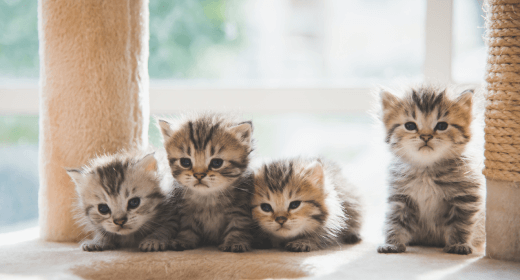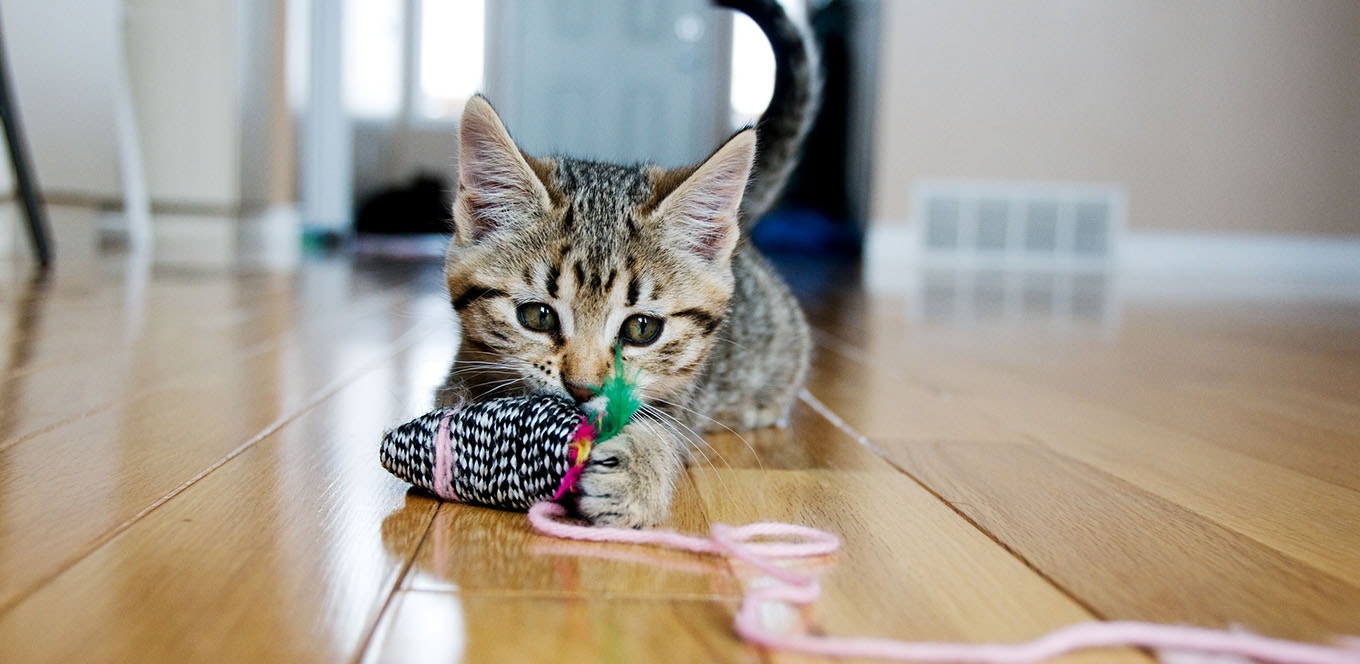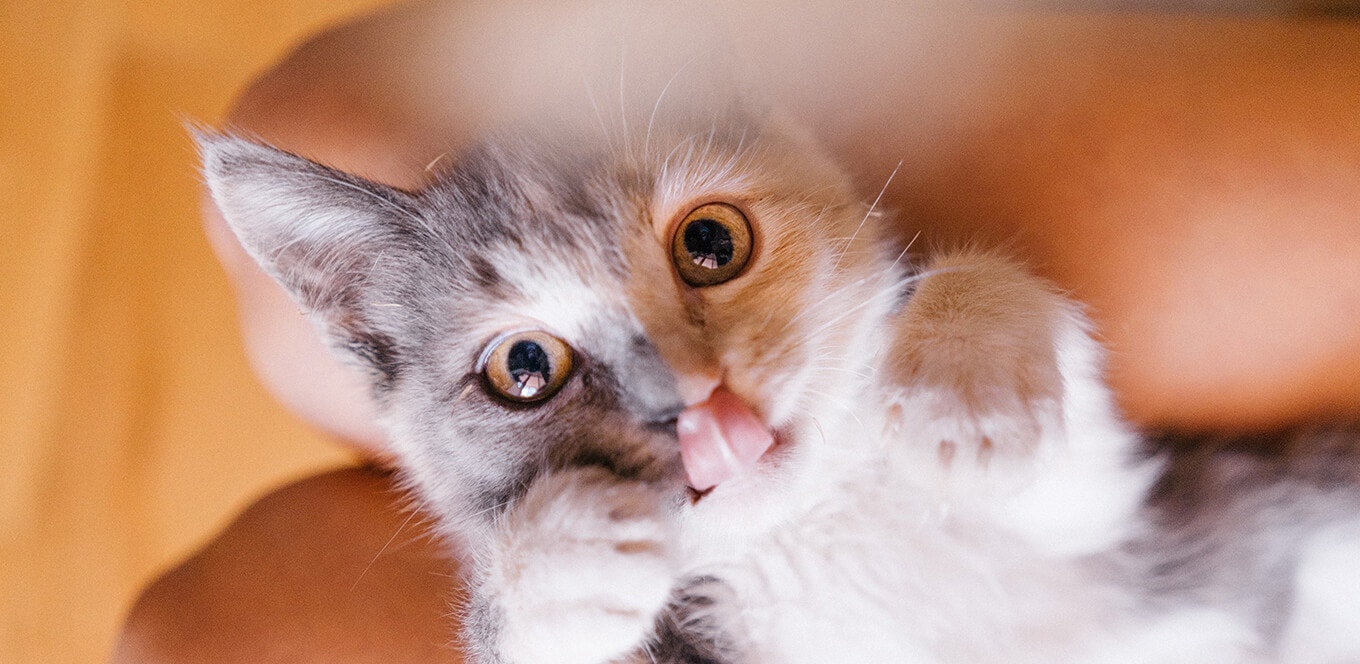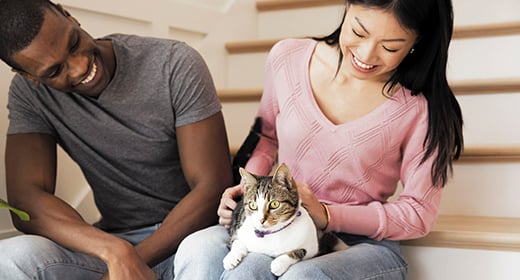

Providing your kitten with the proper nutrition goes way beyond just putting fresh food in a clean bowl. Your kitten’s nutritional needs will change as her body develops through adolescence. Proper nutrition during these critical growth periods will help your kitten mature into a strong, healthy adult cat. Discover four essential kitten-feeding tips you need to know in your kitten’s first year.
Learning what development milestones your kitten will experience in her first year will help you decide what and when to feed her.
After kittens are weaned, they enter a stage of rapid growth, which lasts through the sixth month of life. They need a balanced diet to deliver the nutrients and energy to sustain such rapid development.
Kittens have twice the energy needs of adult cats on a pound-per-pound basis. But their smaller mouths, teeth and stomachs limit the amount of food they can digest during a single meal. Therefore, it may be best to divide their total daily food amount into three or four smaller meals.
Because every bite must be packed with nutrition, kittens require a diet specifically formulated for growth. The best choice is a food with animal-based proteins that is highly digestible, nutrient dense and designed to meet kittens’ unique nutritional needs.
As kittens approach adult size, their nutritional requirements begin to change again. Their rate of growth begins to slow, activity levels may decline and they can start eating fewer, larger meals each day. During this stage, kittens begin to look like adults, but they are still growing and need the special nutrition found in kitten food.
The adolescent growth stage is a time when many cat owners are tempted to change a kitten’s food for variety. But cats do not get bored with a consistent diet of high-quality dry food. You can supplement your kitten’s dry food with a nutrient-dense canned food for a nutritious change of pace.
When your cat is about 12 months old, it’s time to switch to a maintenance formula adult cat food, such as IAMS™ ProActive Health™ Healthy Adult with Chicken. At this age, cats no longer need the extra calories and nutrients for growth supplied by kitten food. As with any change in a cat’s diet, remember to gradually transition from kitten food to adult food over a period of several days.
Monitor your cat’s weight and body condition during the transition, and adjust feeding portions if necessary. Because cats generally eat only what they need, free-choice feeding is fine for most cats. However, some indoor cats that don’t exercise much may overeat if fed free choice. In this situation, portion-controlled feeding twice a day is a good alternative.
Giving a kitten “human food” and table scraps can lead to undesirable behaviors, such as begging or stealing food. Feeding homemade diets or food formulated for adult cats (especially those designed for weight loss), or supplementing a complete and balanced diet with vitamins could cause nutritional disorders.
Kittens and cats are strict carnivores and need the nutrients found in meat. For example, sufficient amounts of taurine, an essential amino acid provided naturally through meat, help cats maintain healthy eyes, heart and reproduction. All IAMS kitten and cat food formulas have optimal levels of taurine for every life stage.




Bringing a kitten home is an experience full of joy and warmth. The internet is filled with kitten photos and videos, and you are soon going to find out why! However, these cute creatures are extremely delicate and need hands-on attention while growing up. If you bring home a kitten without a mother, you will have to be extra careful with it. Every cat parent should be well-informed about how to take care of newborn kittens or kittens in general.
We have put together a few tips to get you started on your journey of raising a kitten. From vet visits and food selection to grooming and keeping it hydrated, this article will give you a basic understanding of how to take care of a kitten.
Routine check-ups are highly recommended for kittens. Once you get a kitten home, your responsibility as a caregiver is to take it to the vet for a basic health check-up. During this check-up, the veterinarian will check for any health concerns that need to be addressed immediately. They will also walk you through the vaccination and spaying/neutering process. If you are a first-time cat parent, do not hesitate from asking doubts and questions regarding your cat’s health and well-being.
Since a dehydrated kitten can be vulnerable to many diseases and infections, make sure that fresh water is easily accessible. In fact, place multiple water bowls around the house for it to drink from. Clean these bowls regularly and fill them up with fresh water. If the vet recommends, you can also give your kitten electrolyte water.
A newborn kitten should be fed by its mother for the first few weeks. However, kitties that find a new home generally get separated from their mother at an early age. If you have adopted a newborn pet, you probably do not know how to take care of a kitten without a mother. Start by visiting a vet to receive a comprehensive feeding guide. It will help you meet the kitty’s nutritional needs. You might also have to switch to a different type of food at different stages like teething.
Cats are carnivores; hence, their food intake is majorly meat. Ensure that the dry food you give your cat is made with high-quality protein. Made with chicken as the main ingredient, IAMS Proactive Health Mother and Kitten is a protein-rich meal option for your kitten. This kitten food also contains Omega 3, Colostrum, and DHA to support healthy eye and brain development!
Cats are independent creatures that enjoy their space. However, from time to time, they also like being cuddled and picked up. They will also show affection in their own unique ways. Give your kitten some time to settle in and gradually start introducing it to your touch. Gently hold it and pamper it. Bring a few fun toys for it to play with. Kittens generally love playing with bells, strings, or anything that they can chase.
Taking care of a kitten involves introducing it to its new family members – including other pets – from the day it is brought home. After all, your new kitten will be the newest addition to the clan! If you are worried about your dog and cat not getting along because of age-old assumptions, let us assure you, it is nothing but a myth. However, some dogs may not be able to differentiate a cat from a rabbit and their prey instincts could kick in. If this happens, you need to train your dog by familiarising it with your kitten’s scent. Most dog breeds are hostile in nature and can coexist with other pets easily. Socialising for your kitten will also include grooming days, check-up days, and more.
Cats love grooming themselves and are very particular about how they look. However, kittens may need some help, especially in cases where they dirty themselves. Your vet will educate you about ways in which you can give your delicate and tiny kitten a bath. Post that, brush your kitten’s fur coat. Now, brushing its coat does not only remove dirt and dead hair, but it also regulates blood circulation, giving your kitty a healthy glow!
Litter training is one of the most important aspects of raising a kitten. Choose a litter box that is big enough for your kitten to do its business. Finding the right type of litter may take some experimenting, but you will soon get there! Fortunately, cats usually eliminate in sandy or granular places by nature. So, when you introduce it to a litter box, chances are that it will use it right away. If your feline friend doesn’t, give it some time to get comfortable. Keep cleaning the litter box periodically to ensure hygiene.
As a cat parent, you must pay attention to your kitty’s sleeping space. Kittens and cats are heavy sleepers; kittens can even sleep for 20 hours a day! For the first few nights, make sure your kitten sleeps next to your bed. It is normal for these feline creatures to cry during the first few days as everything is new. However, your kitten will eventually start getting used to its new space and sleep for long hours. Once it starts doing that, you can set up a cosy corner for it to sleep in. If you are wondering how to take care of a newborn kitten, just make sure that you place it somewhere near your bed. This will help you hear any cries and come to their aid as soon as possible.